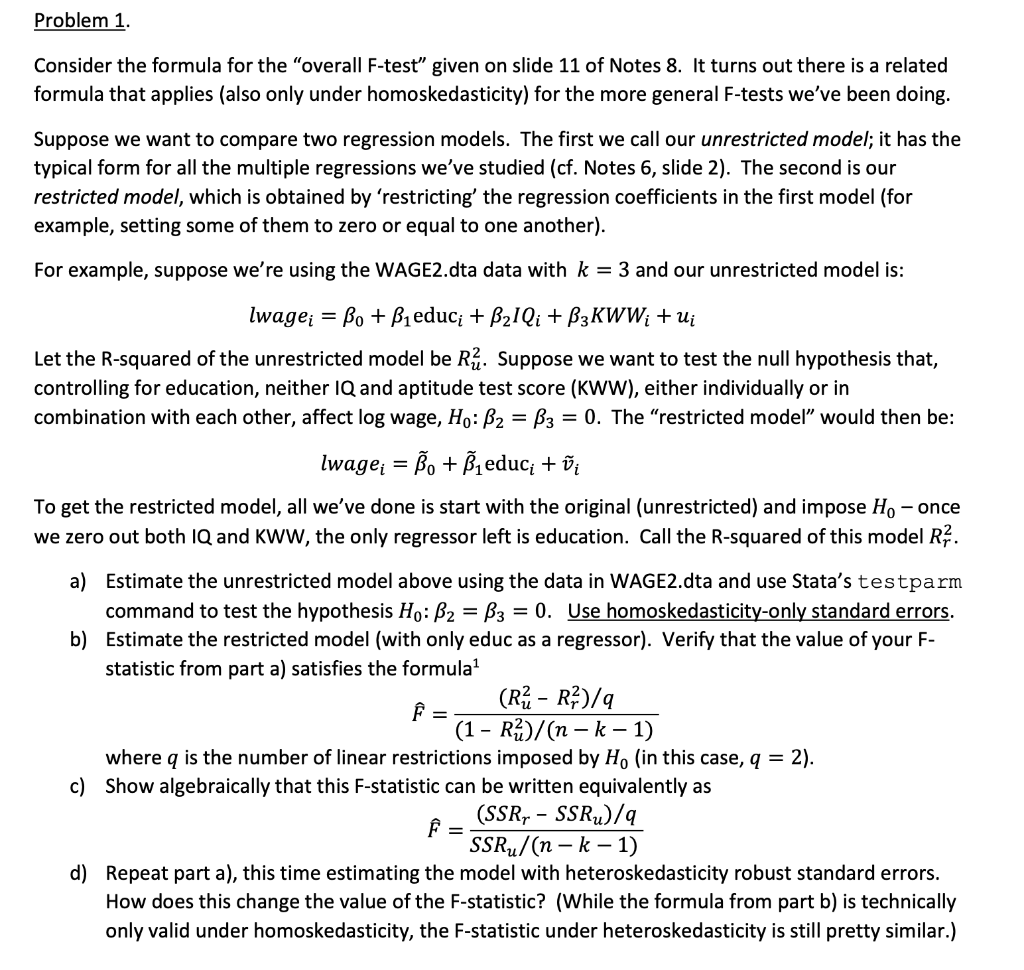
Problem 1. Consider the formula for the "overall F-test" given on slide 11 of Notes 8. It turns out there is a related formula that applies (also only under homoskedasticity) for the more general F-tests we've been doing. Suppose we want to compare two regression models. The first we call our unrestricted model; it has the typical form for all the multiple regressions we've studied (cf. Notes 6, slide 2). The second is our restricted model, which is obtained by 'restricting' the regression coefficients in the first model (for example, setting some of them to zero or equal to one another). For example, suppose we're using the WAGE2.dta data with k = 3 and our unrestricted model is: lwagei = Be + B1 educ; + B21Qi + B3KWW; +ui Let the R-squared of the unrestricted model be R. Suppose we want to test the null hypothesis that, controlling for education, neither IQ and aptitude test score (KWW), either individually or in combination with each other, affect log wage, Ho: B2 = B3 = 0. The "restricted model would then be: = lwage; = Bo + Bi educi + i To get the restricted model, all we've done is start with the original (unrestricted) and impose Ho - once we zero out both IQ and kww, the only regressor left is education. Call the R-squared of this model R. a) Estimate the unrestricted model above using the data in WAGE2.dta and use Stata's testparm command to test the hypothesis Ho: B2 = B3 = 0. Use homoskedasticity-only standard errors. b) Estimate the restricted model (with only educ as a regressor). Verify that the value of your F- statistic from part a) satisfies the formula? (R R?)/q = (1 R%)/(n-k 1) where q is the number of linear restrictions imposed by H. (in this case, q = 2). c) Show algebraically that this F-statistic can be written equivalently as f (SSR, - SSR)/q SSRu/(n- k-1) d) Repeat part a), this time estimating the model with heteroskedasticity robust standard errors. How does this change the value of the F-statistic? (While the formula from part b) is technically only valid under homoskedasticity, the F-statistic under heteroskedasticity is still pretty similar.) = Problem 1. Consider the formula for the "overall F-test" given on slide 11 of Notes 8. It turns out there is a related formula that applies (also only under homoskedasticity) for the more general F-tests we've been doing. Suppose we want to compare two regression models. The first we call our unrestricted model; it has the typical form for all the multiple regressions we've studied (cf. Notes 6, slide 2). The second is our restricted model, which is obtained by 'restricting' the regression coefficients in the first model (for example, setting some of them to zero or equal to one another). For example, suppose we're using the WAGE2.dta data with k = 3 and our unrestricted model is: lwagei = Be + B1 educ; + B21Qi + B3KWW; +ui Let the R-squared of the unrestricted model be R. Suppose we want to test the null hypothesis that, controlling for education, neither IQ and aptitude test score (KWW), either individually or in combination with each other, affect log wage, Ho: B2 = B3 = 0. The "restricted model would then be: = lwage; = Bo + Bi educi + i To get the restricted model, all we've done is start with the original (unrestricted) and impose Ho - once we zero out both IQ and kww, the only regressor left is education. Call the R-squared of this model R. a) Estimate the unrestricted model above using the data in WAGE2.dta and use Stata's testparm command to test the hypothesis Ho: B2 = B3 = 0. Use homoskedasticity-only standard errors. b) Estimate the restricted model (with only educ as a regressor). Verify that the value of your F- statistic from part a) satisfies the formula? (R R?)/q = (1 R%)/(n-k 1) where q is the number of linear restrictions imposed by H. (in this case, q = 2). c) Show algebraically that this F-statistic can be written equivalently as f (SSR, - SSR)/q SSRu/(n- k-1) d) Repeat part a), this time estimating the model with heteroskedasticity robust standard errors. How does this change the value of the F-statistic? (While the formula from part b) is technically only valid under homoskedasticity, the F-statistic under heteroskedasticity is still pretty similar.) =







